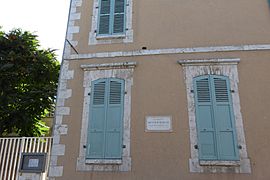Mathurin Régnier facts for kids
Quick facts for kids
Mathurin Régnier
|
|
|---|---|

A 19th century engraving of Régnier
|
|
| Born | 21 December 1573 Chartres |
| Died | 22 October 1613 Rouen |
| Occupation | Satirist |
Mathurin Régnier (born December 21, 1573 – died October 22, 1613) was a famous French writer. He was known for his witty and often critical poems, especially his satires. A satirist is someone who uses humor, irony, or exaggeration to criticize people's mistakes or foolishness.
Contents
Who Was Mathurin Régnier?
Régnier was born in Chartres, a city in France. His father, Jacques Régnier, was a well-off citizen. His mother, Simone Desportes, was the sister of another well-known poet, Philippe Desportes.
Early Life and Family
Philippe Desportes was a rich and popular poet at the royal court. He was seen as Mathurin Régnier's helper and guide. When Mathurin was just eight years old, he began training for a church career. This was a common path for young men hoping to follow in their uncle's footsteps.
Not much is known about Régnier's early years. It is thought that he visited Italy around 1587. He traveled there with François de Joyeuse, a high-ranking church official called a cardinal. The cardinal was representing the French king at the Pope's court.
Régnier found his duties with the cardinal difficult. He traveled a lot for many years. Around 1605, he returned to France for good. He stayed with his uncle, Desportes, who offered him a place to live.
His Later Years
Régnier started writing satirical poems early in his career. His uncle and another poet, François de Malherbe, did not get along. This gave Régnier a reason to write poems criticizing Malherbe.
In 1606, his uncle Desportes passed away. Régnier did not inherit much from him. However, he did receive a yearly payment of 2000 livres from one of his uncle's church positions. In 1609, he also became a canon of Chartres. This happened because of his friendship with Bishop Philippe Hurault. Régnier spent a lot of time at the bishop's abbey, Royaumont, in his later years.
When King Henri IV died, Régnier lost his chance for more important positions. He passed away in Rouen in October 1613, at the age of 39.
What Did He Write?
Around the time of his death, many collections of Régnier's satirical poems were published. Other poems remained as handwritten papers. His confirmed works fall into three main types:
- Regular satires: These were long poems written in a specific French style called alexandrine couplets.
- Serious poems: These were more thoughtful poems written in different styles.
- Short, funny, or sometimes rude poems: These were called epigrams and light pieces.
His Famous Satires
Régnier's true talent shines in his satires. They are strong and well-written. He also wrote beautiful, sad poems. In these, he was inspired by the poet Pierre Ronsard. Régnier even defended Ronsard against Malherbe's criticisms.
In his satires, Régnier was very original. He sometimes followed the Roman poet Horace but always made the poems his own. His words were rich and colorful. He avoided the overly fancy language that some poets used back then.
His poems are very powerful. What makes him a great satirist is how he avoids common ideas. He knew a lot about human nature. Even the famous writer Boileau admired his writing skills.
Régnier was also very smart in how he judged other writers. In one of his famous satires (Satire ix., A Monsieur Rapin), he criticized Malherbe. This part is considered one of the best criticisms of poetry that focuses only on strict rules.
Régnier was also very good at describing things. His "narrative satires" were so vivid that no one in France wrote like that for two centuries after him. His best work is called Macette ou l'Hypocrisie dconcerte. It is a masterpiece that can even be compared to the famous play Tartuffe. Almost all of his sixteen satires are of very high quality.
His first collection, Les Premieres d'Euvres ou satyres de Regnier, was published in Paris in 1608. It included a poem for the king and ten satires. More editions came out in 1609, 1612, and 1613. He also contributed to other collections like Les Muses gaillardes (1609) and Le Temple d'Apollon (1611).
Remembering Mathurin Régnier
- In his hometown of Chartres, a street is named after him. It connects Boulevard Chasles and Place des Halles. On Place des Halles, there is also a stone monument honoring him and his uncle, Philippe Desportes. The Mathurin-Regnier college is also in Chartres.
- A street in Paris, in the 15th area, is named after him. There is also a street with his name in Perpignan.
- In 1842, the writer Alfred de Musset honored him in his poem On laziness.
- Around 1846, the artist Eugène Delacroix created a drawing of him using watercolor.
- Tributes to Mathurin Régnier
See also
 In Spanish: Mathurin Régnier para niños
In Spanish: Mathurin Régnier para niños




